Piolets d'Or Announces the "Significant Ascents" of 2023
This list of 68 climbs is effectively a "long list" used to select nominees of the prestigious alpine award.
The rolling green hills, rocky passes, flower-laden meadows and clear streams of Gorkhi Terelj National Park in northern Mongolia is the birthplace of the Mongols. The Outdoor Journal spent a week on horseback with Stone Horse Expeditions in the heart of this country’s vast wilderness.

Tdrihe Khan Khentii mountains stretched before us, from one end of the azure sky to the other. Tegri, the Great Sky God, watched us with his infinite panorama. From here, I could see miles and miles into the distance. This was the “Forbidden Zone”, that unknown wilderness where Genghis Khan was born. As a child and then again much later on, he hunted here, his true home, on a horse, sheltered in a ger or under the blue sky. When he was a boy, exiled with his family into the cold and harsh wilderness of the northern Mongolian hills, his only friends were what these lands contained. After he built an empire and died, it became a sacred and taboo zone, left to the deer and wolves. For decades the area had been closed off. The Soviets enforced it as a Highly Restricted Area to allow them to do what they wished with it - from logging and military exercises, to also countering any potential rise of Mongolian nationalism around the great Khan. Despite those years, the Area remained wild.
No wonder the Mongols worshipped it.
A day before, we had crossed fresh bear tracks. There were no signs of human presence apart from our train of horses and riders. And now, this vista lay in front of us, green and yellow grassy hills, long valleys, meadows of flowers stretching to higher mountains all the way to Siberia, some still snow-dusted despite the summer sun. Burkhan Khaldun stood further behind higher peaks. And that incredible sky. No wonder the Mongols worshipped it. We all lived once under this blue infinity. As we’d ridden northwards away from Ulan Bator, the city’s pollution had faded away long ago, the gray curse had lifted and my eyes had once again accustomed themselves to what they had evolved to do - see long distances, look for hares, deer, bears, navigate passes and ford streams, climb rocks, and watch falcons circle on thermals above. And over the last few days, we had done all these things.
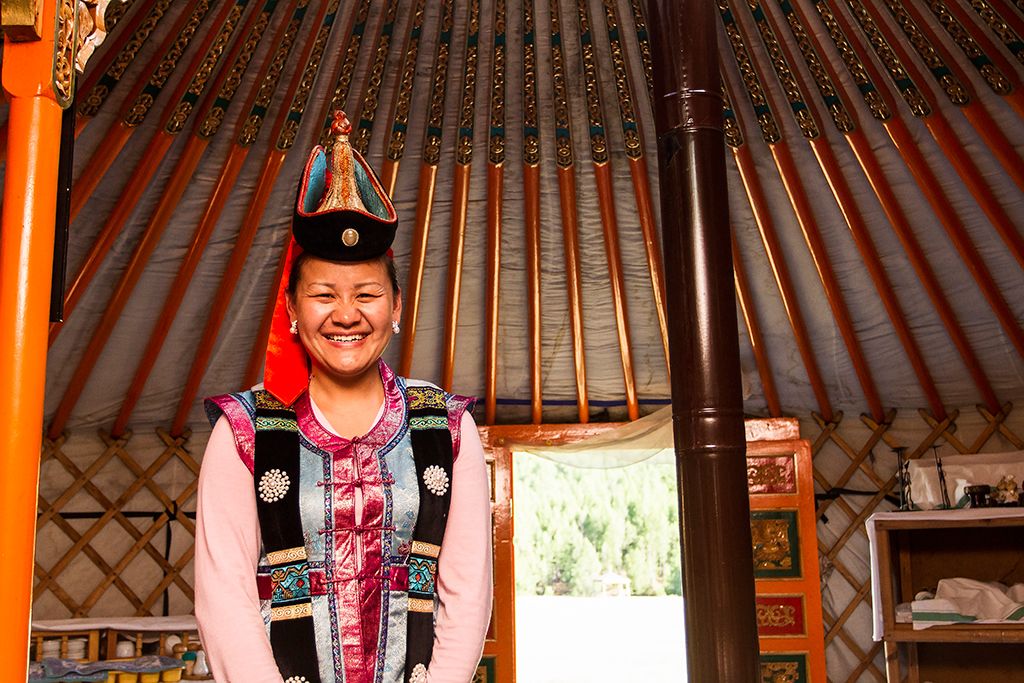
We had left our last camp around mid-morning, some hours ago. One half of the party broke away to ride into another valley out west, while Keith and I wanted to ride up and to the pass in the range of hills that separated the Gorkhi Terelj from the Khan Khentii. We skirted the granite mounds which punctuated the ends of this valley, forded a marshy grassland below the campsite, fought off the bloodsucking horseflies that made our horses’ lives miserable for a little while, eventually entering a tall forest of larch and birch. The ground began to rise as we entered a narrow rocky trail that started to wind uphill. Jerry, my sturdy, stubborn little Mongolian horse plodded on. This easy gait was infinitely more comfortable than the long trots of our previous days in the saddle. Keith Swenson, a taciturn, the 64 year-old owner of Stone Horse Expeditions along with his wife Sabine Schmidt, showed none of the wear I felt - my skin of my thighs were quite literally raw after 50 kilometers of riding and trotting in the wilderness. After a few days Keith opened up with wisecracks. “People ask what do you do, and I say I’m a rider”, says Keith, punning on his American accent. “They think I mean ‘writer’, “and they ask, what have you written?” “So I say, Blackie, Brownie, Ol Dirty Face…”, naming his horses.
These lands, however remote, are important.
Halfway up the trail was a shaman’s totem, poles placed on the ground to make a conical structure, wrapped with bits of fabric and ribbons. But at the base, and near a tree, we also found broken shards of glass, vodka bottles drunk and thrown by unknown travelers who no longer respected their old ways. We’d been riding for an hour or so and we stopped for a short break in the little opening in the forest. It was quite warm in the strong sun, perhaps 30C like every day of the summer, but cold at nights, often dipping below freezing.
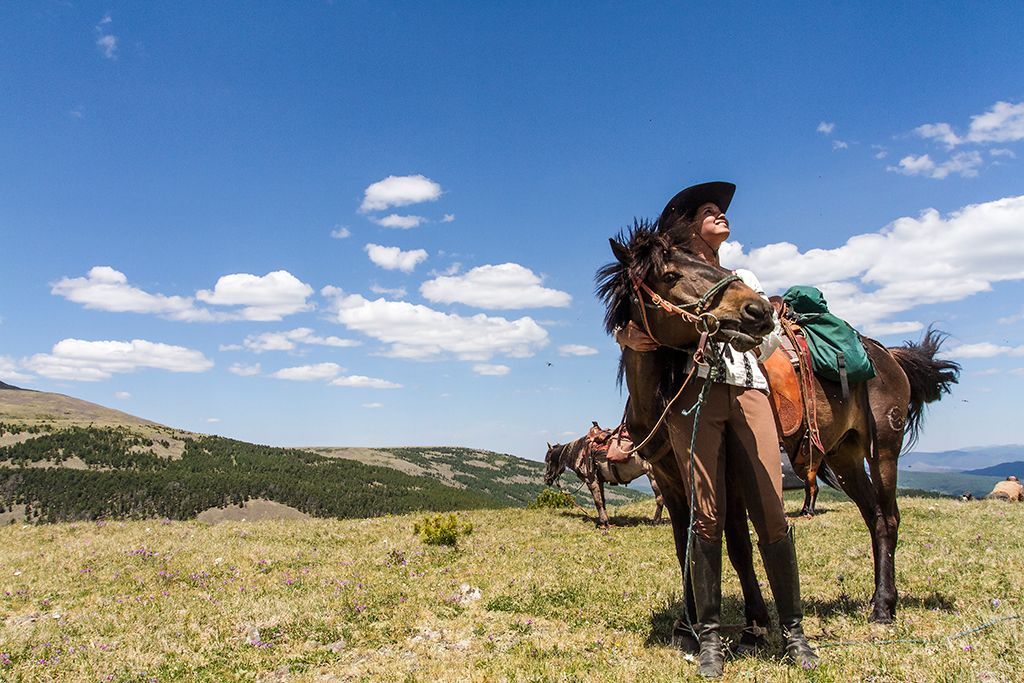
The Mongols invented the modern world*
The old ways are important. These lands, however remote, are important. The Mongols invented the modern world*. When, at the age of 55, Genghis Khan rode out into Asia and Europe, he created the largest empire known to humanity, as well as its first international postal system, and the largest free-flowing network of ideas, trade and culture. But today, Mongolia feels relatively isolated and far away, landlocked in the Eurasian continent. And getting there turned out to be a greater adventure than we’d expected. Instead of flying, we took the famous Trans-Mongolian from Beijing to Ulan Bator. At 11pm, the train pulled into the last station on the China-Mongolia border to change the undercarriage (the railway gauge is different in Mongolia). Three hours later we got back on the train and waited patiently for the Chinese guards to hand us all our passports back. Our intern’s passport was returned ripped from its cover. Before anyone could make a move, the train entered Mongolia… where the Mongolian border guard insisted that the 18-year old girl get off the train because she wasn’t allowed to enter on an invalid passport. Twenty minutes of arguing later, at nearly three am, we got off and watched the train leave without us.
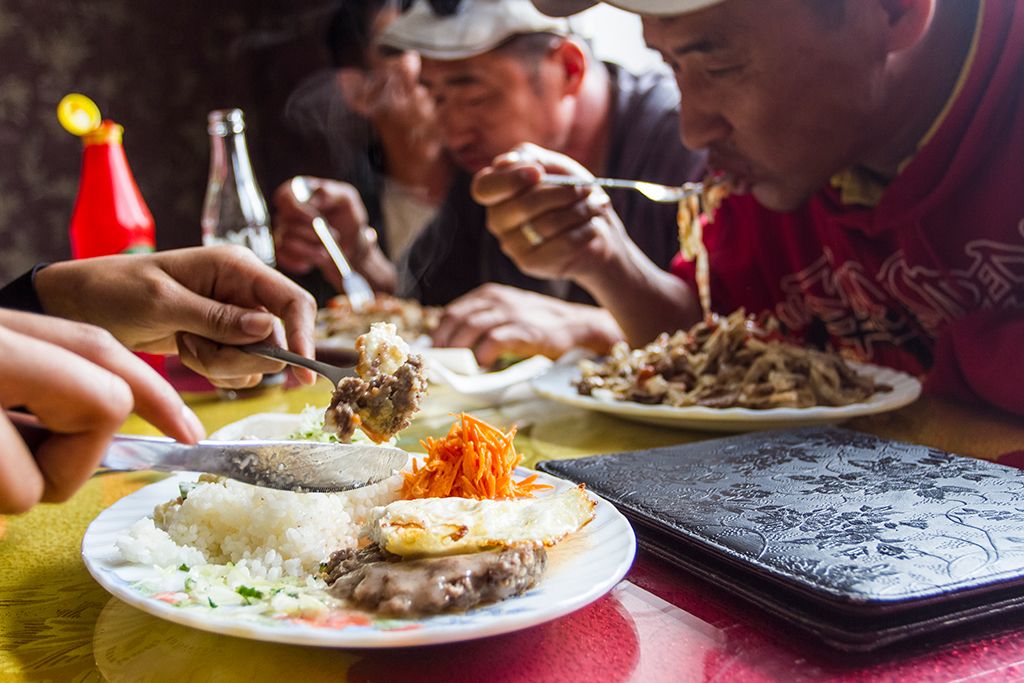
Fifteen hours later, after many phone calls and emails to various embassies and important officials, she was finally allowed to enter the country. The Trans-Mongolian having long gone, we finagled an eight-hour taxi ride across the great steppes (on a second-hand car coming off a goods train) for $45. Welcome to Mongolia.
I did not have much riding experience, but I usually don’t let a little thing like that deter me from a trip. Keith, once also a climber, agreed that anyone up for adventure would be perfectly fine on a Mongolian horse. They were sturdy and forgiving. We all gathered at their staging camp an hour’s drive from Ulan Bator - a Singaporean couple on their second trip with Stone Horse, their friend from Hong Kong, a French diplomat from Swaziland, our team of three, Keith, Sabine and their crew - Nyamaa, Buyana and Jackson, the American intern. Soon, our team of 16 horses and Stinky the Mongolian Dog, a most genuine companion if there ever was one, were off towards the north. Day one went reasonably well, with a short four hour ride to our first campsite inside the Gorkhi Terelj National Park. The other experienced riders asked me various questions about how I felt and whether my horse had cantered or galloped, and I said I didn’t know, but the horse seemed to know what it was doing. Apparently, they have many gaits.
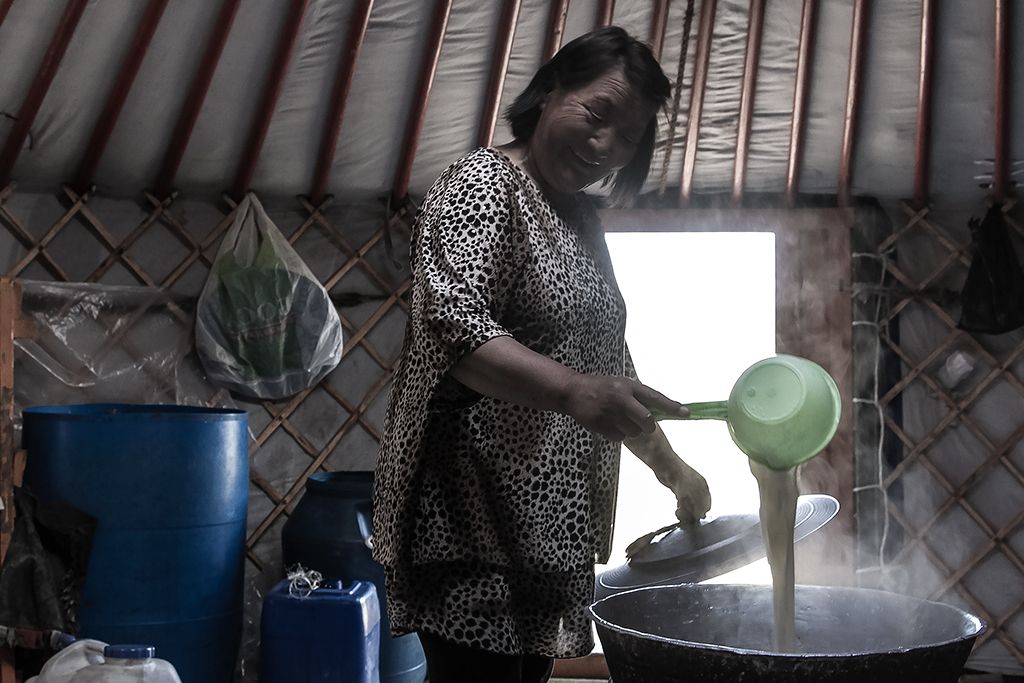
I learned what that meant the next day.
The morning begins easily and we move along a gentle valley. At a stream, the horses bend to drink. They’re herd animals, comfortable only in their own numbers. Suddenly, there’s a commotion as one of the pack horses spooks and bolts. We’re unprepared, and good old Jerry decides to follow the bolting horse too, suddenly turning 180 degrees and galloping wildly. I have to pull firmly on the reins to stop him, while the teamsters have to get the other fella back. He’s bucking around wildly, his unshod feet stamping, his grass-eating brain telling him that that bee sting he felt on his hind was a wolf’s nip. Stinky ignores the commotion, running ahead happily back in his favorite hunting grounds, chasing ground squirrels to their holes. We continue, entering a forest and then riding uphill to a pass. On the other side, a wide open valley, and our first real gallop. Now I feel the sensation, riding with the animal as one, gently cycling my feet in the stirrups and gripping with my knees, all of it coming naturally to me and I urge Jerry on, on, on. Chhoo, Jerry, Chhoo! We stop at a babbling brook in the valley below where we wash our faces. Are we in paradise?
And then the long trot begins. For a horse, it’s the most comfortable way to move. But it’s bouncy. I try to “post” like all the real riders. Watching me grimace in agony, Keith smiled and said, “real men trot,” as he rode along comfortably with that rolling ankle movement to compensate for the horse’s bumpy ride. “Trotting is how the Mongols moved such vast distances. If you make him gallop, you won’t get very far, you’ll kill the horse”.
[gallery type="rectangular" td_select_gallery_slide="slide" size="medium" ids="6531,6529,6528,6527,6525,6523"]
a melting pot of humanity and ethnicities
But Mongolia changed the course of human history since long before the great Khan and his riders, the ultimate, self-sufficient soldiers. Apart from the Mongols, it is also the original homeland of the Huns and the Turks. It is a melting pot of humanity and ethnicities, where thousands of years ago two language families met and separated - the Indo-Europeans and the Altaics - and possibly where the wild horse was first tamed, thereby changing the course of history. When men on horses first raced out of Central Asia, first ancient Mesopotamia, then Egypt fell. Europe’s original ‘mother culture’ and India’s Harappan civilization disappeared. Humans, moving incredible distances on horses, spread across Asia, from the western end of Europe to Korea, all the way down to Arabia and India, creating nearly all the cultures we know today. Some of the languages they spoke evolved today into English, and others evolved into Japanese, but some of their words have become so intermingled that it’s hard to distinguish which came from which. Hindi is an Indo-European language, but today the common Hindi word for “home” is “ghar” (from the Sanskrit “grhá”) which is nearly identical to the Altaic Mongolian’s word for home, ger.
When the Hunnu (“Huns”) fought the Chinese Hans, the clans that lost fled towards Europe, creating Hungary, as well as leading to the downfall of the Western Roman Empire. Centuries later, the Turkics originally from the Mongolian steppes came hurtling into Constantinople, wiping out the Eastern Roman Empire.
We ride through rocky hills and rock formations, up and down defiles, over passes and across shallow streams, through meadows of flowers and knee-high grass. We ride all day, and every evening set up our traveling camp like the Mongols of old. We sleep in modern-day lightweight tents, under trees or under the stars, breathing cold clear air, drinking from fresh rain-fed streams, eating atop rocks while falcons circle above and the horses graze.
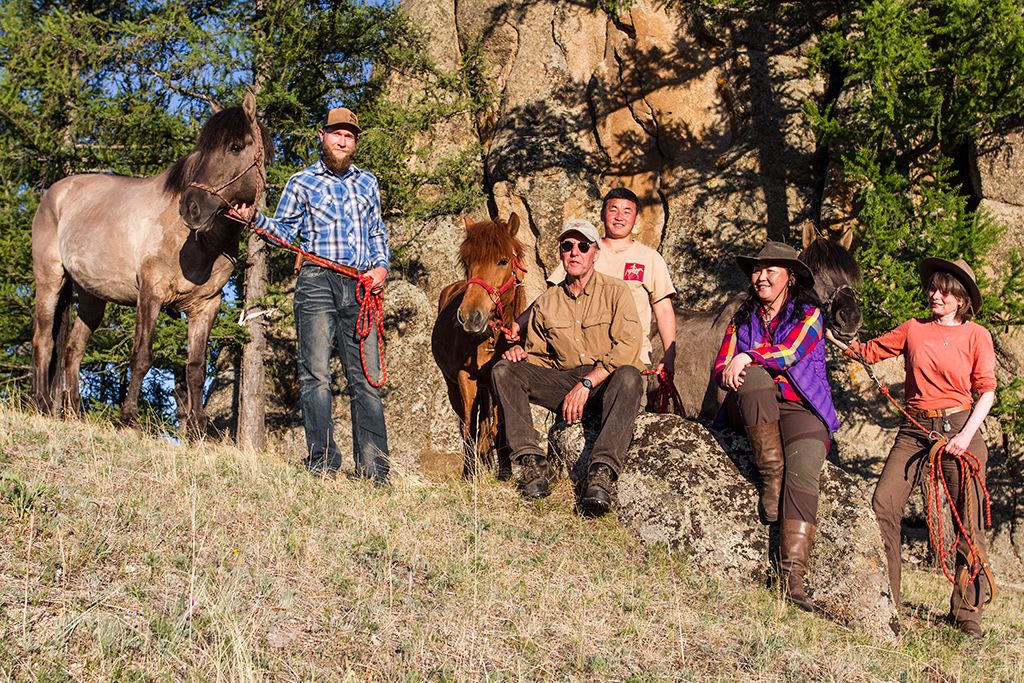
The world has continued to change, but horses and men will forever ride together.
One day we stretched out the ride to reach a farther campsite, a Hunnu gravesite. We set up our tents atop 2000-year old graves, low mounds of stones marking the places where men, women, children and horses were laid to rest. “I believe that these people would have loved us to be here, living like they did,” said Keith. When they hear our horses, they’ll feel alive”. The next morning, I pulled my horse off to a side and to a vantage point to shoot the group riding further down the valley. Jerry stomped and neighed angrily as the herd passed him by, but I held him back. When the group disappeared into the distance, I quickly packed my camera gear back into the saddlebags. Then jumping back on, I let the horse fly as he wished, back to his herd. Jerry, the funny but tough little horse, galloped madly a mile north over the gently rising slope. Our hooves rang out in the valley, as two large round mounds, Hun graves, emerged in front on the mountainside. Neither Jerry nor I needed to veer, and we galloped directly over the centre of the mounds, the sound of our hoofbeats gladdening passed Hunnu souls. Their ancestors, our ancestors, had once tamed wild horses, and together changed the world. The world has continued to change, but horses and men will forever ride together.
Images by Madhuri chowdhury.
2nd best newsletter in the universe